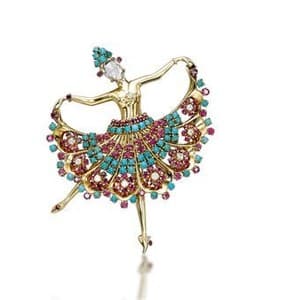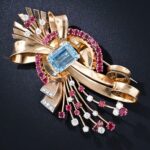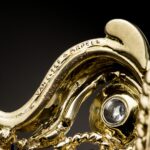
Rubel was an American jeweler famous for his 1940s angel and dancer brooches. Before he became its competitor, John Rubel worked for Van Cleef & Arpels. His company, John Rubel Co. was one of its Parisian manufacturing jewelers. In 1939, Rubel moved to New York to help produce jewelry for Van Cleef’s recently opened shop in the city. Both firms shared designer Maurice Duvalet, a Frenchman who reputedly “brought chic to everything he touched.”1 Duvalet designed ballerina and cupid-motif brooches for both firms. The designs were highly successful. In 1943, the collaboration with Van Cleef ended, and Rubel opened his own showroom at 777 Fifth Avenue. In the years that followed, Rubel created jewels depicting French cancan dancers, Spanish flamenco dancers, the Rockettes, Louis XVI style dancers, and dancing flowers inspired by the film, Fantasia. The firm also produced a series of popular flower motif brooches featuring rubies, diamonds, and turquoise—a combination that was widely copied by other jewelers. It is, moreover, credited for popularizing domed cocktail rings with matching earrings.2 In 1947, the firm closed its doors.
Maker's Marks & Timeline
Rubel Frères
| Country | |
|---|---|
| City | London, New York NY, Palm Beach FL, Paris |
| Symbol | acorns, cartouche, frame, leaf, lozenge, oval, rhombus |
| Shape | cartouche, frame, lozenge, oval, rhombus |
| Era | c.1925-1950 |
22 rue Vivienne, later 16 avenue de l’Opéra Paris France – Rubel Frères
777 Fifth Avenue, New York NY – John Rubel
Specialties
- Began as a Parisian manufacturing firm, Rubel Frères, in association with Van Cleef & Arpels.
1939: Moved to New York to take care of production at Van Cleef & Arpels.
- Nephew Marcel handled the firm in Paris.
1943: Discontinued their affiliation with Van Cleef & Arpels and opened under their own name John Rubel.
Jewelry designs
- Baguette diamond necklaces.
- Dancer brooches.
- Flamenco dancers.
- Rockettes.
- Louis XVI Style.
- Cancan.
- Fantasia-inspired dancers.
- Flower Brooches with ruby, diamond and turquoise.
- Domed cocktail rings and matching earrings.
Designer
- Maurice Duvalet (shared with VCA.)
1950: Closed their American business and returned to France.
Mark Struck 1915
Related Reading
Sources
- Proddow, Penny & Debra Healy. American Jewelry: Glamour & Tradition. New York: Rizzoli, 1987.





